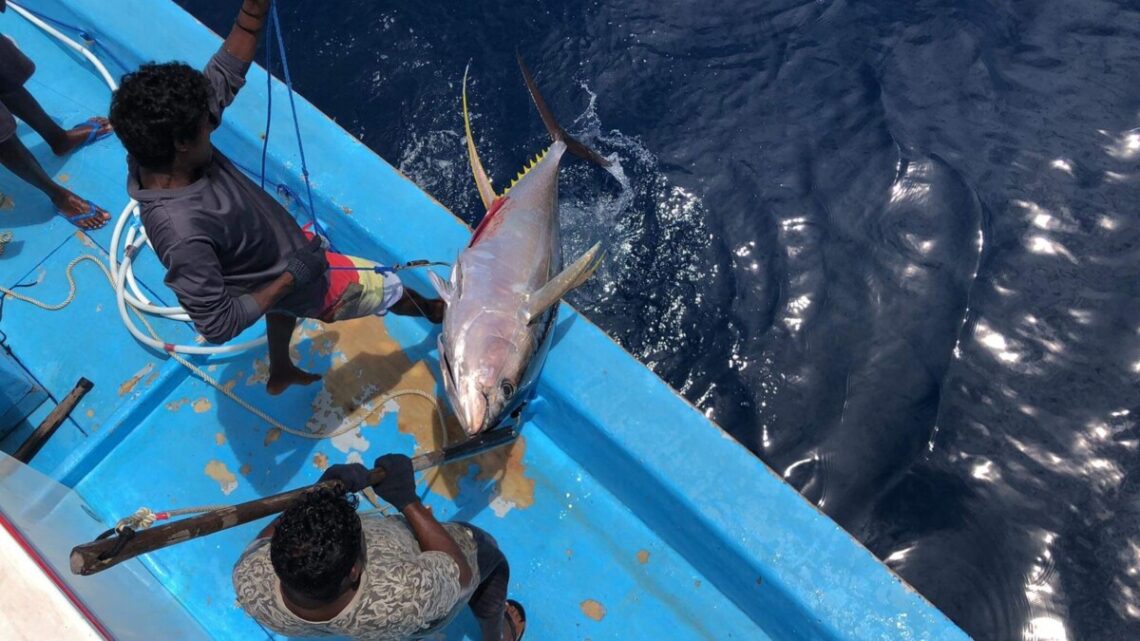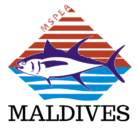
Handline fishery is one of the most economically important in the Maldives. Current landings are about 40,000 MT annually exporting 80%, mostly in fresh chilled form earning about 70millions USD a year.
The fishery targets surface-dwelling large yellowfin tuna, often associated with dolphins. While Maldivans know of the fishery potential for those associations, a targeted fishery started in a big way in the late 1990s following the private sector involvement in fresh tuna exports. Livebait, often scads and trigger fishers, are used to attract and maintain large yellowfin tuna schools. Hooked livebait on handline leads with sinkers are used to catch yellowfin and hauled manually. The fish are killed immediately, gilled, gutted and bled before storing on flake ice.
The fishery is highly selective with no bycatch and virtually no negative interactions with ETP species.
The scope of the FIP is the entire Maldives handline fishery, conducted throughout the archipelago, but generally restricted south central, central and northern regions. The Maldives fishery segment is part of the wider Indian Ocean yellowfin tuna stock, but which targets essentially adults.
Of the 800 or so licensed tuna vessels about 50% are handline vessels targeting exclusively yellowfin from handling. The fishing licenses are renewed every year.
The Maldives Seafood Processors and Exporters Association (MSPEA) attempted to obtain MSC certification for the Maldives handline yellowfin fishery in 2011 and 2013. However, IOTC-wide stock related issues hampered its successful certification. MSPEA has MSC certification on Maldives pole-and-line skipjack tuna since 2012. Initially certificated with eight conditions, and closing all its conditions in the first 5 year period is currently in its second cycle with only one condition (PI 3.2.3 – compliance and enforcement). Given that the same management authority, the Maldives Ministry of Fisheries, Marine Resources & Agriculturemanages both pole-and-line and handline fisheries and that both are highly selective and well known for its low ecological impact there is no reason to believe there would be issues in MSC certification requirements of P2 and P3 for handline yellowfin tuna.
With this in mind the primary objective of the Maldives Yellowfin Tuna Handline Fishery Improvement Program (Maldives YFT HL FIP) is to advocate developing credible and effective conservation and management measures for the rebuilding of the overfished Indian ocean yellowfin stock. On this, it is also the goal engane scientific community.
Essentially an advocacy FIP, however, the goal is also to achieve an unconditional MSC certification. In doing so we have approached an MSC certified CAB for a comprehensive pre-assessment who found scores less than 80 for livebait and ETP, their information and management under MSC Principle 2.
It is therefore the objective to work on an action plan to improve those areas to close these conditions in the second year of the 5-year program.
Principle 1 Performance Indicators that would required to work are:
- PI 1.1.1 Stock Status
- PI 1.1.2 Stock Rebuilding
- PI 1.2.1 Harvest Strategy
- PI 1.2.2 Harvest Control Rules and Tools
Principle 2 Performance Indicators that would require to work are:
- PI 2.2.2 Secondary Management
- PI 2.2.3 Secondary Information
- PI 2.3.2 ETP Management
- PI 2.3.3 ETP Information
Except for the PI 1.1.2 on stock rebuilding, the Maldives Yellowfin Tuna Handline Fishery would be a conditional MSC pass between 60-79. Closing of this condition requires the IOTC to adopt credible and robust stock rebuilding plans on scientific evidence which demonstrates the stock is improving by reducing the gap in the Biomass and Fishing Mortality targets. The stock was declared overfished and subjected to overfishing in 2015 and a rebuilding plan has been in pace since 2016. However, to date there has not been significant progress. The recent Special Session of the IOTC (March 08-12, 2021) failed to reach consensus on revision to the existing rebuilding plan proposed by the Maldives, considered to be the most credible and promising proposal.
The goal of the MSPEA would be to promote actions to implement a rebuilding plan for the YFT stock that is expected to allow an increase in the stock to a point that it is at or fluctuating around Bmsy. MSPEA with support from its members would demonstrate activities in the Maldives for reducing its allocated catch and advocate other members to follow the Maldives by example with the view towards demonstrating responsiveness of any UoA-based harvest control rule.
The Maldives Ministry of Fisheries with support from the MSPEA would promote actions to implement an IOTC-wide effective Harvest Strategy, supported by appropriate and effective Harvest Control Rules and Tools. Local activities that are done under the FIP will demonstrate that harvest controls can be responsive to the Maldives handline fleet. These than wil be used to advocate other IOTC members to do the same.
Acquisition of the livebait information and development to strengthen the existing Livebait Management Plan would be conducted to close the conditions reaching SG > 80. Similarly the activities to demonstrate improved ETP (Endangered Threatened and Protected) species information and management would result in an unconditional pass of SG > 80.
